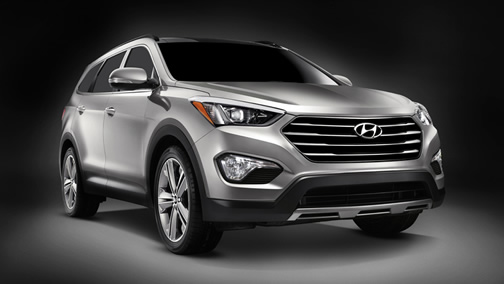|
|
||||||||
That power figure is up nearly 30 horses, though down about 15 in torque, from the turbo four, and about 100 horses and nearly 70 torquish items more than the base four cylinder engine offers. It's also about equal to Acura's new MDX (except for the torque), but since the big Santa Fe is lighter and it should therefore feel a little more nimble than the more luxury-oriented (and expensive) Acura. All things being equal, of course.
They aren't equal, naturally - there are more differences between a true luxury vehicle such as the Acura and a more mainstream vehicle with luxury options such as the Santa Fe, but as far as being a mainstream crossover vehicle is concerned, the Santa Fe has nothing to apologize for. And that's probably just as well, since it has no mouth with which to speak.
The current generation Santa Fe sports Hyundai's "fluidic sculpture" design philosophy, which works sometimes and doesn't work others (it works great on the Elantra, not as well on the Sonata). It works fine here, though the extra length doesn't help much. Still, it's an attractive and modern exterior that houses an attractive and modern interior.
Power gets to either the front or all four wheels via a six speed automatic transmission that features a "Shiftronic" manual mode. No paddles, alas, and while the transmission works well and has a good number of "gears" it seemed reluctant to kick down and did so with a bit of a jerk. Well, the jerk may have been controlling the transmission...
The all wheel drive system only sends power to the front wheels under normal driving conditions - as a way to save fuel - distributing power to the rears only as the system deems necessary.
Other than that, the vehicle drives fine. The independent suspension is about what you'd expect - more rugged than you get in the average sedan, but not bowel-activating rough either - and the steering and brakes work and feel good. Brakes are four wheel discs, with ABS, Electronic Brake-force Distribution (EBD) and Brake Assist (BA).
The steering features those seemingly unique to Hyundai driver selectable modes, which are kind of like a sport setting but not quite. But it works okay and when you choose sport mode it does make the drive more "enthusiast compatible." You get three operating modes in all: Comfort, Normal and Sport. Hyundai says comfort mode is ideal for city and parking environments (it makes the steering wheel the easiest to turn compared with the other modes) by reducing steering effort by 10 per cent compared with Normal mode. Sport mode tightens up the effort by another by 10 percent from Normal and despite the extra tightness, steering is still smooth and easy.
Hyundai Canada's sample Santa Fe XL Luxury was quite loaded and very nice, yet there were a couple of things about it that could use a rethink: the LCD screens. Both the one on the center stack and the one on the instrument panel are quite small, yet they're crammed full of information. This makes it hard to fathom anything at a quick glance. It would be better if less information was shown at once and/or the screens were stretched by at least 30 per cent.
But that, and the kick down shifts, are about the only things to quibble about with the Santa Fe. Even the base Santa Fe comes standard with stuff like heated front seats, power windows, driver's seat power lumbar support, a six-speaker audio system, Bluetooth, tilt/telescoping steering wheel with audio controls, cruise control, and a lot more. Most of that's pretty mainstream, but it's good stuff to have.
Well, except for the audio system. Hyundai offers three systems, including a higher end Infinity that - given Infinity's history in the audio field - probably sounds great. The high end system also boasts a 4.3 inch color LCD screen and rear view camera. Hyundai Canada's Santa Fe XL Luxury test vehicle came with the middle system and it was of such quality that I'd hate to hear the entry level one: the upgraded system sounded weak and muddy, though it was great ergonomically.
The Luxury edition also included a really nice panoramic sunroof.
If you need room, the Santa Fe XL comes through, with increased second row legroom (50 millimeters more) and an extra 156 liters of cargo capacity compared to the five passenger "Sport." There's also rear-passenger HVAC controls and vents as standard equipment.
Santa Fe XL's third row bench seat splits and folds 50/50 and you can choose either from a 40/20/40 split/folding second row bench seat (for seven passenger use) or second row captain's chairs that reduce the seating capacity by one, but which will be more pleasant for those in the middle row.
Safety equipment on all Santas Fe includes a Vehicle Stability Management (VSM) system which incorporates a Rollover Protection System and "optimally manages the ESC (Electronic Stability Control) and the Motor-Driven Power Steering (MDPS) to help the driver maintain control of the vehicle in slippery conditions or during fast cornering." Whew! There's also traction control, of course, as well as seven airbags including one for the driver's knee and dual front impact, seat-mounted front-side impact, and side curtain airbags.
The Hyundai Santa Fe XL starts at $29,999 for the base, front wheel drive model, which seems like a pretty good deal for what you get. Add on the packages and the extra driven wheels and the price goes up accordingly. For example, the Luxury AWD version starts at $39,199, while the top line model with saddle leather lists for $43,199.
Competition includes the Toyota Highlander, Mazda CX-9, Nissan Pathfinder and Honda Pilot.
Copyright 2013 Jim Bray
TechnoFile.com
Jim Bray is a member of the Automobile Journalists Association of Canada. His columns are available through the TechnoFile Syndicate.
Reviews by Brand |

